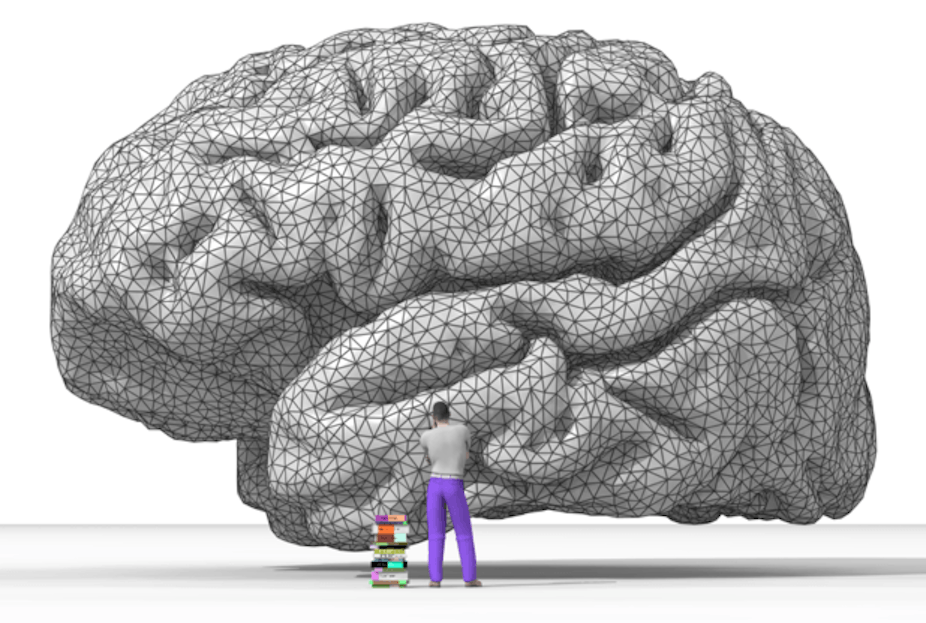In the first article in this series, we saw how the mind and body literally cannot be separated, and also why robotics isn’t capable of replicating either one.
But let’s assume that we’ve solved the problems of sensors and muscles and all the rest, and accept that the uploaded brain won’t truly reflect our mind. Now comes the big challenge: uploading the brain. But what is a brain exactly? This term usually refers to the cortex and possibly some subcortical structures, including the amygdala, hippocampus and basal ganglia. But the central nervous system is actually made of several other structures that are no less critical, including the cerebellum, thalamus, hypothalamus, medulla and brain stem.
Making the connections
If we consider the whole central nervous system, we are facing an average of 86 billion neurons, and each of these neurons contacts an average of 10,000 other neurons, representing a grand total of approximately 860 billion connections. This is really huge. So exactly what do we have to upload into the computer? The type, the size and the geometry of each neuron? Its current membrane potential? The size and position of the axon and its state of myelination? The complete geometry of the dendritic tree? The location of the various ion pumps? The number, the position and the state of the different neuro-mediators? Any of these could be critical, and they can only be taken into account in state-of-the-art computer models (and for a few neurons only). The problem is that we do not know exactly what it is that makes us who we are and different from anyone else (and I’m not even talking about learning).
As a fallback – and only if we had the proper tools to record each of these parameters once – we could try to transfer everything. However, this would require potentially some thousands or even millions of pieces of information for a single neuron. If you consider just the number of neurons, we would reach a figure in the zetta domain (for your information, the order is kilo, mega, giga, tera, peta, exa and zetta, multiplying by 1,000 at each step). This number is so huge that it cannot yet be manipulated as a whole by computer science. And we are talking only about the brain’s storage, because we also have to ensure that this model runs in real time, since nobody would happily accept a silicon mind that runs at reduced speed. From a purely technical perspective, we are thus very far (really very far) from making this to happen.
Worse, research indicates that Moore’s Law – which suggests that computer power doubles every 18 months – is reaching its limits, suggesting that we may never attain the necessary level of technology. The Human Brain Project foresaw this problem and planned from the beginning to use only simplified models of neurons and synapses. If you’re interested in more accurate models, take a look at the OpenWorm project, which doesn’t pretend to simulate any more than a few neurons.
The bird in the machine
This idea of transferring one’s brain into a machine is widespread in both literature and cinema. It has gained renewed interest with recent advances in artificial intelligence. However, there may be some confusion regarding what is actually artificial intelligence (AI) and what are its goals.
When media cover artificial intelligence, they generally refer to machine learning and robotics, neither of which really seeks to understand the brain or cognition (with some notable exceptions, such as the work of Pierre-Yves Oudeyer). This confusion likely stems from the fact that new algorithms have been designed that enable excellent performance on tasks that were previously thought to be reserved for humans – recognizing images, driving a car and so on.
But if machine learning and robotics are progressing at an amazing speed, this does not tell us anything about how the biological brain works (at least not directly). If we want to know, we have to look at neuroscience and more specifically at computational neuroscience. A parallel could be drawn between aeronautics (AI) and ornithology (neuroscience). Even though the early attempts at flying were directly inspired by the flight of birds, this was abandoned long ago in favor of the design of ever more efficient aircraft (speed, payload, etc) using techniques specific to aeronautics. To better understand birds, you must turn to ornithology and biology. Hence, talking about uploading a brain to a computer because of the progress of AI makes as much sense as gluing feathers on an airplane and pretending it’s an artificial bird.
No one knows if it will ever be possible to “upload a brain to a computer.” But what is certain today is that in the current state of science, this statement makes no sense and will remain so without a major epistemological breakthrough in our understanding of the brain and how it works.


